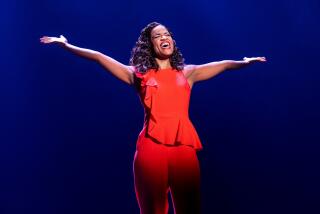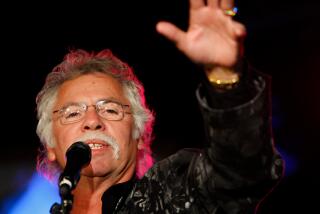Tuneful Trio Comes Back to Life
SAN DIEGO â Whatâs that? You say you woke up this morning to the sound of your own head vibrating in three-part harmony?
Well, as your doctor, Iâd suggest taking the waters at Baden-Baden, but assuming the HMO wonât sign off on that , letâs stick closer to home. Clearly the vibrations were caused by the show you saw at the Globe Theatres over the weekend.
Structurally wobbly but musically sublime, it goes by the name âThe Boswell Sisters.â It was created by Stuart Ross, best known for the four-part harmonic convergence known as âForever Plaid,â and by Mark Hampton (âFull Gallopâ).
For years, Ross has monkeyed with versions of a Boswell tribute, attempting to capture what many of us find so addictive in the sistersâ close harmony and weeping-willow soulfulness, their pungent, swinging way with a melody.
The Andrews Sisters, who hit big just as the Boswells broke up, may be better known today. But they couldnât hold three candles to Connee, Vet (short for Helvetia) and Martha Boswell. In the 1920s and â30s, they were sold as the âsyncopatinâ songbirds from New Orleans,â and their musically scrupulous yet easygoing ways--a fine match for radio--found a wide audience.
Connee, who used a wheelchair and other conveyances owing to a childhood accident (often misattributed to polio), served as lead singer. Hers is one of the great, gorgeous voices of 20th century popular song, as supple as mid-â50s Sinatra, or any-era Ella Fitzgerald. When a teenaged Fitzgerald won a talent contest in 1934, she won it imitating Connee Boswell, who, as she said, âdid things that no one else was doing at the time.â The lead Boswell scatted, bent and reconfigured melody lines like a jazz soloist, and when she sang--in that yearning, sensual alto--about the South, or a man, it was the sound of something that mattered.
The Boswells once got a hate letter: âGet those savage chanters off the air!â one displeased radio listener wrote. More than a hint of racism was inherent in such a letter. Connee Boswell cited the African American blues singer Mamie Smith as a key inspiration. In the Boswellsâ vocals, you hear an aural gumbo made up of black and white and Creole influences, spirituals and ha-cha, decorum and abandon.
All of this is touched upon, at least, in the freely fictionalized âBoswell Sisters.â
The premise: Sometime after World War II, at the upstate New York farm run by Martha Boswell (Amy Pietz, from âCaroline in the Cityâ), the sisters reunite to rehearse for a March of Dimes benefit performance. Vet (Michelle Duffy) relays the story of the reunion to us, as a flashback. Often she replays bits of an argument or a conversation for our amusement.
Connee (Elizabeth Ward Land), the self-described âbossy perfectionist,â has her share of asides to the audience, too, as does Martha. Eventually two conflicts emerge: Will Martha, who feels abandoned by her sisters, sell the farm? And will the reunion hold long enough to get the Boswells through the benefit performance?
Ross and Hampton acknowledge the familial tensions that led to the sistersâ scattering in the first place, but theyâre uncertainly addressed. The showâs makers want a good-time diversion, complete with an audience sing-along on âShine On, Harvest Moon.â Yet, the way itâs structured, late in Act 2 âThe Boswell Sistersâ turns into a profile in Conneeâs courage. The melodramatically ruthless climax has her standing at the microphone for âStormy Weather.â
None of the tonal clashes or conceptual pile-ups matters much, if youâre hot for the music. Itâs a lovely staging, and the Boswells have been superbly cast. Landâs Connee sounds remarkably like the real thing, especially on the long âoâ vowel sounds. Duffyâs Vet is pure, effortless period charm, to whom audience rapport comes as naturally as breathing. Pietzâs Martha is more contemporary-seeming, but she has a wonderfully quick way with the exposition.
Theyâre backed by a Dixie-inflected onstage quintet led by musical supervisor Brad Ellis at the piano. (The sharp orchestrations and arrangements are by Peter Matz and Joseph Baker, respectively.) Ann Hould-Wardâs costumes for the Boswells couldnât be better or more beautifully delineated.
When Duffy, Land and Pietz are flying through âItâs the Girl,â or donning âTop Hat,â or having their own sweet way with âWhen I Take My Sugar to Tea,â the showâs irresistible. But for the sake of future incarnations, I hope âThe Boswell Sistersâ takes a tip from that musical-comedy maven, Henry David Thoreau: simplify, simplify. Thereâs something about the flashback structure that frustrates. If Ross and Hampton can better intertwine the story it wants to tell with all that swell music, who knows? They might end up with a âForever Boswell.â
âThe Boswell Sisters,â the Globe Theatres, Old Globe Theatre, Balboa Park, San Diego. Tuesdays-Fridays, 8 p.m.; Saturdays, 2 and 8 p.m.; Sundays, 2 and 7 p.m. Ends Sept. 1. $20 to $50. (619) 239-2255. Running time: 2 hours, 15 minutes.
Michelle Duffy: Vet
Elizabeth Ward Land: Connee
Amy Pietz: Martha
Written by Stuart Ross and Mark Hampton. Directed by Stuart Ross. Musical supervision by Brad Ellis. Scenic design by James Youmans. Costumes by Ann Hould-Ward. Lighting by David F. Segal. Sound by Paul Peterson. Orchestrations by Peter Matz. Arrangements by Joseph Baker. Stage manager D. Adams.
More to Read
The biggest entertainment stories
Get our big stories about Hollywood, film, television, music, arts, culture and more right in your inbox as soon as they publish.
You may occasionally receive promotional content from the Los Angeles Times.










